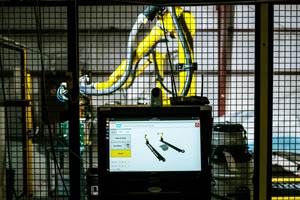Robotic riveting cell suited to automatic fastening for composite frames, components
CAMX 2025: The Belotti ARC is an integrated system that rapidly and automatically manages multiple types of rivets and Time-Serts.
Share
Belotti Automatic Riveting Cell (ARC) | Belotti
Belotti’s (Suiso, Italy and Irving, Texas, U.S.) Automatic Riveting Cell (ARC) is the company’s novel robotic cell featuring an under-patent riveting head for the rapid, automated application of the entire range of Time-Sert inserts and rivets of different diameters on composite frames and components across multiple industries — like automotive and aerospace — a task traditionally performed manually by the operators.
Many parts made of composite materials — including frames, monocoques, doors, roofs and structural elements for the automotive sector — and wings and various aircraft components, are characterized by thin thicknesses that do not allow for sufficiently strong surfaces to insert fasteners necessary to ensure the assembly of various elements together.
Belotti ARC is the result of a strategic partnership with Cosberg Co. (Terno D’isola, Italy), stemming from a shared commitment to address the growing complexities of industrial production. ARC enables a precise application of key elements, ensuring rapid, flexible and under-controlled execution without requiring a head change, ensuring maximum efficiency and adaptability.
Belotti ARC includes a Comau six-axis anthropomorphic robot; a compact, floating head; four-position rotary tables — one or two tables for a modular configuration; Siemens Sinumerik One CNC with Run MyRobot; and an automatic feeding system.
The robotic cell is capable of managing rivets and Time-Sert inserts of different diameters automatically. Anthropomorphic, it emulates the flexibility of the human wrist, enabling access to even the most challenging areas. The Belotti ARC also features ISO programming language for seamless operation, and enables precise control of all parameters. The Belotti ARC provides real-time process tracking and feedback for optimal accuracy.
Related Content
-
Broetje-Automation demonstrates rCF placement via AFP
Through the ScrapSeRO project, the system integrator and machine builder successfully processed recycled composites, in addition to more traditional materials, via its highly flexible Staxx One system.
-
TAVieDA project team cuts aircraft door production time using thermoplastic composites, welding
Fraunhofer groups, Trelleborg and Airbus develop modular, fully automated assembly system concept to replace metals and time-consuming assembly that shows potential for scalability.
-
Plyable releases AI-powered mold design tool
Plyable continues to rid composites engineers of workflow bottlenecks through an end-to-end automated system — from mold design to quotation to manufacturing fulfillment.
Related Content
Broetje-Automation demonstrates rCF placement via AFP
Through the ScrapSeRO project, the system integrator and machine builder successfully processed recycled composites, in addition to more traditional materials, via its highly flexible Staxx One system.
Read MoreTAVieDA project team cuts aircraft door production time using thermoplastic composites, welding
Fraunhofer groups, Trelleborg and Airbus develop modular, fully automated assembly system concept to replace metals and time-consuming assembly that shows potential for scalability.
Read MorePlyable releases AI-powered mold design tool
Plyable continues to rid composites engineers of workflow bottlenecks through an end-to-end automated system — from mold design to quotation to manufacturing fulfillment.
Read MoreAI-powered robotic solutions support high-mix manufacturing
AI startup offers automation innovations for high-mix, high-variability, manual surface finishing applications.
Read MoreRead Next
Ceramic matrix composites: Faster, cheaper, higher temperature
New players proliferate, increasing CMC materials and manufacturing capacity, novel processes and automation to meet demand for higher part volumes and performance.
Read MoreNext-gen fan blades: Hybrid twin RTM, printed sensors, laser shock disassembly
MORPHO project demonstrates blade with 20% faster RTM cure cycle, uses AI-based monitoring for improved maintenance/life cycle management and proves laser shock disassembly for recycling.
Read MoreCutting 100 pounds, certification time for the X-59 nose cone
Swift Engineering used HyperX software to remove 100 pounds from 38-foot graphite/epoxy cored nose cone for X-59 supersonic aircraft.
Read More









